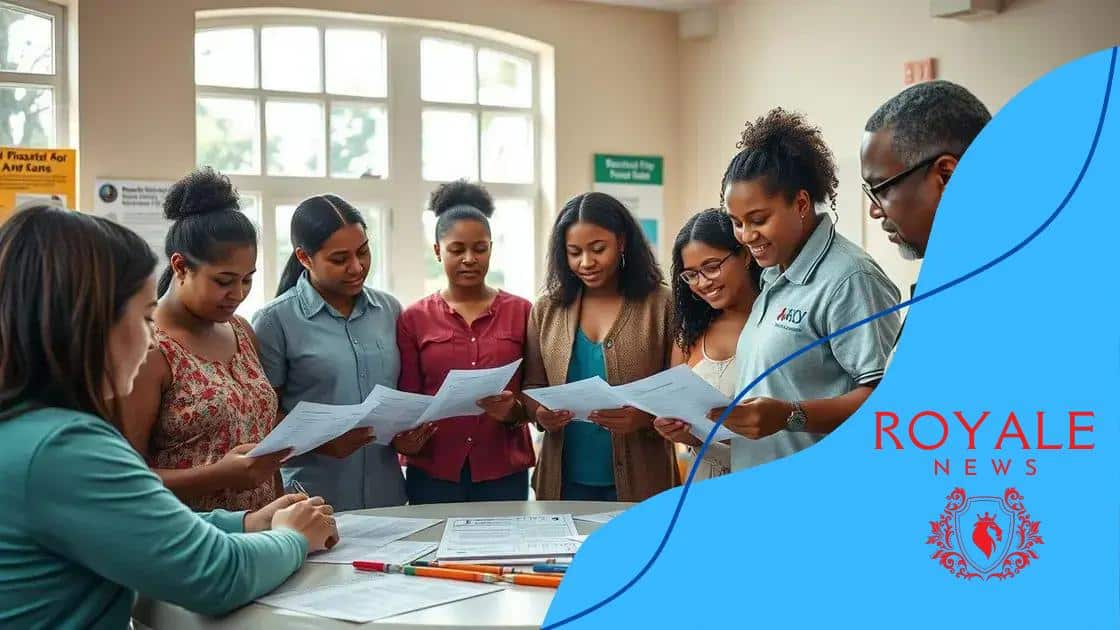Emergency financial aid programs for disaster victims

Emergency financial aid programs for disaster victims provide essential support, including housing assistance, food aid, and medical services, helping individuals rebuild their lives after a disaster.
Emergency financial aid programs for disaster victims play a crucial role in providing support when it’s needed the most. Have you ever wondered how these programs can help individuals and communities recover?
Understanding emergency financial aid
Understanding emergency financial aid is vital for individuals and families facing unexpected disasters. These programs are designed to provide immediate financial assistance to help victims recover and rebuild their lives.
In the aftermath of a disaster, many people experience financial instability. They may lose their homes, jobs, or access to essential resources. Emergency financial aid helps bridge the gap during this critical time, ensuring that basic needs are met and allowing individuals to focus on recovery.
Types of emergency financial aid
There are various forms of aid available for disaster victims. Each type is geared towards different needs:
- Direct cash assistance: Often provided immediately to help with basic living expenses.
- Housing assistance: Supports individuals with temporary housing needs or repairs to their damaged homes.
- Food assistance: Programs that ensure access to food supplies for affected families.
- Healthcare assistance: Helps cover medical and mental health services during recovery.
Identifying the type of aid you may qualify for is essential. Each program has specific eligibility criteria, which can vary by state or organization.
Eligibility criteria for aid programs
Most emergency financial aid programs require applicants to meet certain criteria. Common requirements include:
- Proof of income loss: Documentation showing how your income has been affected by the disaster.
- Residency requirements: Applicants usually must live in the affected area.
- Identification: Valid ID and other personal documents to verify your identity and situation.
Understanding these requirements can streamline the application process. It’s essential to gather necessary documents before applying, as this can help expedite your aid request.
In summary, emergency financial aid programs play a crucial role in supporting victims of disasters. By understanding the types of aid and eligibility criteria, individuals can effectively navigate the recovery process.
Types of disaster financial assistance
Understanding the types of disaster financial assistance available can greatly help those in need after a disaster. These programs are designed to cater to various situations, ensuring that financial support reaches individuals and families effectively.
The main forms of disaster financial assistance include direct aid, which provides cash for immediate needs, and various subsidies, which cover specific expenses like housing or food. Knowing the different types can help victims access the right resources during tough times.
Direct financial assistance
Direct financial assistance is often the quickest way to help individuals meet their urgent needs. This aid can come in various forms:
- Cash grants: These funds are provided without the need for repayment and can be used for various necessities such as food and clothing.
- Emergency loans: Typically low-interest loans designed for quick access, helping people cover unexpected expenses.
- Housing assistance: Support for temporary housing or home repairs that allow victims to stabilize their living situation.
Each option aims to address immediate concerns and help people return to their daily lives as smoothly as possible.
Specialized assistance programs
In addition to direct aid, there are specialized assistance programs that focus on specific needs post-disaster. Here are some examples:
- Food assistance: Programs that ensure access to adequate nutrition, including food vouchers or temporary food banks.
- Medical assistance: Coverage for health-related expenses, including mental health services that may become necessary after a disaster.
- Educational assistance: Support for children impacted by disasters, ensuring they can continue their education amidst challenges.
Overall, accessing the right type of financial assistance can significantly improve recovery efforts for disaster victims, enabling them to rebuild their lives with dignity.
Eligibility criteria for aid programs

Understanding the eligibility criteria for aid programs is crucial for individuals seeking assistance after a disaster. These criteria determine who qualifies for various types of financial support, ensuring that aid reaches those who need it most.
Typically, aid programs set specific guidelines that applicants must follow. Addressing these requirements can help streamline the application process and increase the chances of receiving assistance.
Common eligibility requirements
Most programs require potential recipients to meet certain fundamental criteria, including:
- Residency: Applicants usually must have resided in the affected area during or after the disaster.
- Income level: Many aid programs take into account the pre-disaster income of applicants to ensure that assistance targets those in greatest need.
- Proof of disaster impact: Documentation is often needed to demonstrate how the disaster affected the applicant, whether through property damage, loss of income, or other means.
These requirements help agencies allocate resources effectively and ensure that assistance is provided to the most vulnerable populations.
How to apply
Applying for aid can seem daunting, but understanding the process can simplify it. First, gather the necessary documents that verify your eligibility. This includes proof of identity, income statements, and any records of damage caused by the disaster.
Once the documentation is ready, check the specific program guidelines for submitting an application. Many organizations have online platforms that allow for quick applications, while others may require in-person visits.
Keeping in mind the eligibility criteria and preparing the required documents can make the application process smoother, increasing the likelihood of receiving much-needed assistance during critical times.
How to apply for emergency aid
Knowing how to apply for emergency aid can make a significant difference for those affected by disasters. The application process may seem overwhelming, but understanding the steps involved can help ease the stress.
First, it’s important to gather all necessary documents before starting the application. This ensures that your submission is complete and helps prevent delays. Key documents typically include proof of identity, evidence of the disaster’s impact, and income verification.
Steps to apply
Applying for emergency aid usually involves several straightforward steps:
- Check eligibility: Review the requirements for the specific aid program you intend to apply for. Each program has its own criteria.
- Collect necessary documents: Gather all relevant paperwork that supports your application.
- Complete the application: Fill out the form accurately. Many programs provide online applications that are easy to navigate.
- Submit your application: Follow the submission guidelines carefully to ensure you don’t miss any steps.
After submission, keep track of your application status. Many programs offer a way to check if your application has been received and if any additional information is needed.
Support resources
If you need assistance during the application process, there are resources available to help:
- Community outreach centers: Many communities have local groups that offer support and guidance for applying for aid.
- Helplines: National helplines provide assistance and can answer questions about the application process.
- Online resources: Government and nonprofit websites often have detailed instructions and FAQs about applying for aid.
These resources can help ensure that you submit a complete and accurate application, increasing your chances of receiving much-needed assistance during difficult times.
Impact of financial assistance on recovery
The impact of financial assistance on recovery can be significant for those affected by disasters. Financial aid serves as a crucial lifeline, enabling individuals and families to regain stability and rebuild their lives after a crisis.
Receiving financial support allows victims to meet their immediate needs, such as food, shelter, and medical care. When individuals have access to necessary resources, they can focus on long-term recovery without the constant worry of basic survival.
Short-term benefits
In the short term, financial assistance can alleviate immediate stressors. Key benefits include:
- Access to essentials: Aid helps families purchase food, clothing, and medicine they may have lost in the disaster.
- Temporary housing: Financial support can cover costs for temporary accommodation, allowing them to avoid homelessness.
- Transportation costs: Funds can assist with travel, making it easier for individuals to reach job opportunities or essential services.
These immediate benefits help ensure that survivors can stabilize their situations quickly, which is vital for emotional and mental health.
Long-term recovery effects
Beyond immediate needs, financial assistance plays a crucial role in long-term recovery. When victims receive ongoing support, they can focus on rebuilding their lives.
With financial aid, individuals can invest in:
- Home repairs: Funds can facilitate necessary renovations to restore damaged homes.
- Job training programs: Assistance allows individuals to gain new skills and improve employability in a changing job market.
- Education for children: Financial support ensures that children continue attending school, leading to better opportunities in the future.
Overall, the impact of financial assistance extends far beyond immediate relief. By addressing both short-term and long-term needs, it helps create a foundation for sustainable recovery and resilience.
In conclusion, financial assistance programs are vital in supporting recovery after disasters. They play a crucial role in helping individuals and families meet immediate needs and building a pathway for long-term stability. By understanding the types of aid available and the eligibility criteria, affected individuals can access the resources they need to restore their lives. Ultimately, effective financial aid not only provides temporary relief but also lays the groundwork for a more resilient future.
FAQ – Frequently Asked Questions about Emergency Financial Aid for Disaster Victims
What types of financial assistance are available for disaster victims?
Disaster victims can access various types of financial assistance, including direct cash grants, housing support, food assistance, and medical aid.
How can I check my eligibility for aid programs?
Eligibility typically depends on residency in the affected area, income level, and proof of disaster impact. Review specific program guidelines for details.
What documents do I need to apply for emergency aid?
Common documents include proof of identity, income verification, and evidence of damage caused by the disaster.
How does financial assistance impact recovery?
Financial assistance helps meet immediate needs, provides housing support, and allows for long-term recovery through job training and education.





